Wielu użytkowników WordPressa woli pracować nad swoimi witrynami internetowymi przy użyciu lokalnego serwera na swoim komputerze. Pozwala to na prywatną pracę nad twoją witryną internetową przed udostępnieniem zmian online.
Ostatecznie trzeba będzie przenieść ją na serwer rzeczywisty, aby udostępnić ją odwiedzającym online. Przejście to ma kluczowe znaczenie dla zapewnienia prawidłowego funkcjonowania Twojej witryny internetowej na witrynie na żywo.
Pracowaliśmy nad wieloma lokalnymi witrynami internetowymi, więc musieliśmy nauczyć się najłatwiejszego sposobu przenoszenia treści na żywe witryny.
W tym artykule przedstawimy instrukcje krok po kroku, jak przenieść WordPressa z serwera regionalnego na witrynę live.
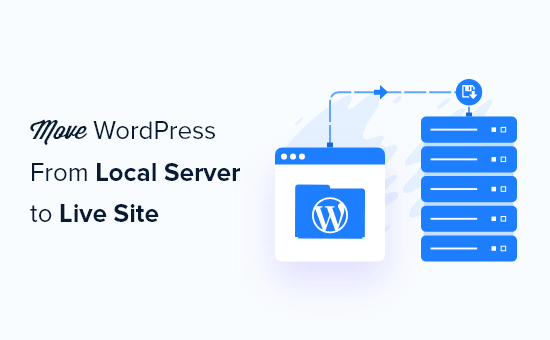
Dlaczego warto przenieść WordPressa z serwera lokalnego na witrynę Live?
Zbudowanie twojego bloga WordPress na lokalnym serwerze to bezpieczny sposób na testowanie zmian w witrynie internetowej bez posiadania wpływu na odwiedzających.
Po zakończeniu udoskonalania twojej witryny internetowej, następnym krokiem jest przeniesienie jej z lokalnego serwera na witrynę działającą na żywo.
Pokażemy dwa sposoby na przeniesienie twojej witryny z serwera regionalnego do witryny na żywo.
Pierwsza metoda wykorzystuje wtyczkę do migracji WordPress i jest zalecana dla początkujących.
W drugiej metodzie pokażemy, jak ręcznie przenieść WordPressa z lokalnego serwera na witrynę live.
Możesz wybrać metodę, która najbardziej Ci odpowiada:
Przed migracją twojej witryny WordPress
Aby przeprowadzić migrację WordPressa z serwera regionalnego na serwer rzeczywisty, trzeba mieć kilka rzeczy na miejscu.
Po pierwsze, zakładamy, że masz witrynę WordPress działającą na serwerze lokalnym (zwanym również localhost) na twoim komputerze i że masz do niej pełny dostęp.
Następnie musisz mieć nazwę domeny i hosting.
Słyszeliśmy niezliczone relacje od początkujących, którzy zaczynali od kiepskich lub darmowych dostawców hostingu i żałowali tego. Z naszego doświadczenia wynika, że wybór odpowiedniego dostawcy hostingu ma kluczowe znaczenie dla sukcesu każdej witryny internetowej.
Aby ułatwić twoją decyzję, zalecamy skorzystanie z Bluehost. Jest to oficjalnie rekomendowana firma hostingowa WordPress, która daje użytkownikom WPBeginner ekskluzywną zniżkę + darmową domenę i SSL.
Zasadniczo możesz zacząć już za 1,99 USD miesięcznie.
Jeśli szukasz świetnej alternatywy dla Bluehost, możesz spojrzeć na Hostinger. Oferują również ekskluzywną zniżkę dla użytkowników WPBeginner z bezpłatną nazwą domeny.
Jeśli możesz sobie pozwolić na zapłacenie nieco więcej, sprawdź SiteGround. Mają też specjalną ofertę dla czytelników WPBeginner.
Jeśli potrzebujesz pomocy w stworzeniu swojej witryny internetowej, skorzystaj z naszego przewodnika krok po kroku.
Wreszcie, będziesz potrzebował programu FTP i wiedzieć, jak korzystać z FTP, aby przesłać twoją witrynę na serwerze lokalnym do witryny na żywo.
Gotowy? Rozpocznijmy migrację twojej witryny WordPress.
Film instruktażowy
Jeśli wolisz pisemne instrukcje, czytaj dalej.
Metoda 1: Przenieś WordPressa z regionalnego serwera na witrynę Live za pomocą wtyczki migracyjnej (zalecane)
Ta metoda jest łatwiejsza i zalecana dla początkujących. Będziemy używać wtyczki do migracji WordPressa, aby przenieść WordPressa z lokalnego hosta do witryny na żywo.
Krok 1: Instalacja i konfiguracja wtyczki Duplicator
Najpierw musisz zainstalować i włączyć wtyczkę Duplicator na twojej regionalnej witrynie. Aby uzyskać więcej informacji, zobacz nasz przewodnik krok po kroku, jak zainstalować wtyczkę WordPress.
Pro Tip: Istnieje również wersja pro Duplicator, która oferuje zabezpieczenia kopii zapasowych, przechowywanie w chmurze, łatwe przywracanie witryn i wiele więcej.
Po aktywacji należy przejść do strony Duplicator ” Backups i kliknąć przycisk “Create New”.
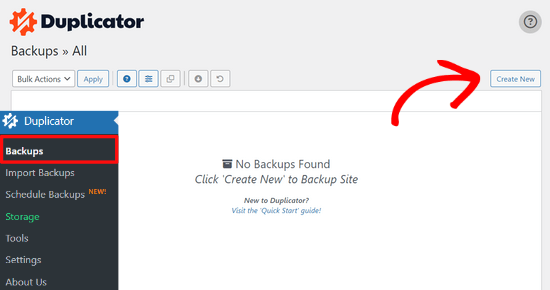
Spowoduje to wyświetlenie ekranu, na którym można nadać nazwę twojej kopii zapasowej.
Następnie kliknij przycisk “Dalej”.

Duplicator przeprowadzi teraz kilka testów, aby sprawdzić, czy wszystko jest w porządku.
Jeśli wszystkie elementy są oznaczone jako “Dobre”, kliknij przycisk “Utwórz”.

Proces ten może potrwać kilka minut, w zależności od rozmiaru twojej witryny internetowej. Należy pozostawić tę kartę otwartą do czasu jego zakończenia.
Po zakończeniu zobaczysz opcje pobierania pakietów “Installer” i “Archive”. Należy kliknąć przycisk “Pobierz oba pliki”, aby pobrać oba pliki na komputer.

Plik “Archiwum” to kompletna kopia twojej witryny WordPress. Zawiera wszystkie pliki rdzenia WordPressa, a także twoje obrazki, przesłane pliki, motywy, wtyczki i kopię zapasową bazy danych WordPress.
Plik “Installer” to skrypt, który zautomatyzuje cały proces migracji poprzez rozpakowanie pliku archiwum zawierającego twoją witrynę internetową.
Krok 2: Utwórz bazę danych dla twojej witryny internetowej WordPress na żywo
Przed uruchomieniem instalatora lub przesłaniem witryny WordPress z hosta lokalnego na twój serwer hostingowy, musisz utworzyć bazę danych MySQL dla nowej witryny na żywo.
Jeśli utworzyłeś już bazę danych MySQL, możesz pominąć ten krok.
Aby utworzyć bazę danych, należy przejść na kokpit cPanel twojego konta hostingowego. Następnie znajdź sekcję “Bazy danych” i kliknij ikonkę “Kreator baz danych MySQL”.
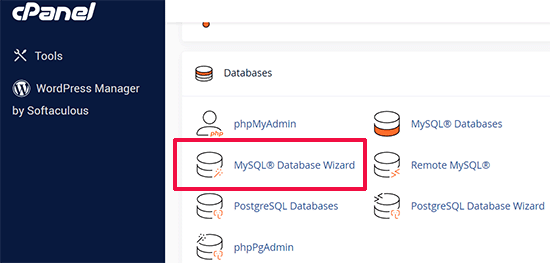
Na kolejnym ekranie znajduje się pole do utworzenia nowej bazy danych.
Wystarczy podać nazwę twojej bazy danych i kliknąć przycisk “Utwórz bazę danych”.

cPanel utworzy teraz nową bazę danych.
Następnie wpisz nazwę użytkownika i hasło dla twojego nowego użytkownika, a następnie kliknij przycisk “Utwórz użytkownika”.
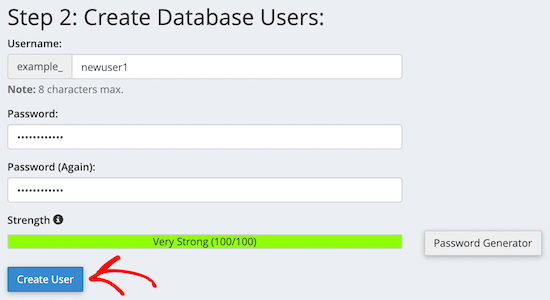
Następnie należy dodać utworzonego użytkownika do bazy danych.
Najpierw kliknij pole wyboru “Wszystkie uprawnienia”.
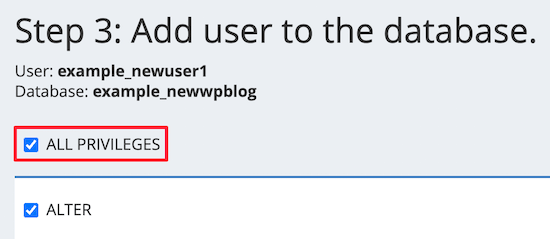
Następnie przewiń w dół i kliknij przycisk “Wprowadź zmiany”, aby zapisać twoje zmiany.
Twoja baza danych jest teraz gotowa do użycia z witryną WordPress. Pamiętaj, aby zanotować nazwę bazy danych, nazwę użytkownika i hasło. Informacje te będą potrzebne w następnym kroku.
Krok 3: Przesyłanie plików z serwera lokalnego do witryny internetowej WordPress na żywo
Teraz należy przesłać archiwum i pliki instalatora z twojej regionalnej witryny na twoje konto hostingowe.
Najpierw połącz się z twoją witryną na żywo za pomocą klienta FTP. Po połączeniu upewnij się, że katalog główny twojej witryny internetowej jest całkowicie pusty.
Zwykle katalogiem głównym jest katalog /home/public_html/.
Niektóre firmy hostingowe WordPress automatycznie instalują WordPress podczas rejestracji. Jeśli masz tam pliki WordPress, musisz je usunąć.
Następnie możesz przesłać pliki archive.zip i installer.php z Duplicatora do twojego pustego katalogu głównego.

Krok 4: Uruchomienie skryptu migracji
Po przesłaniu plików migracyjnych należy przejść na następujący adres URL w twojej przeglądarce:
http://example.com/installer.php
Nie zapomnij zastąpić “example.com” twoją własną nazwą domeny.
Spowoduje to uruchomienie kreatora migracji Duplicator.
Instalator przeprowadzi kilka testów i zainicjuje skrypt.
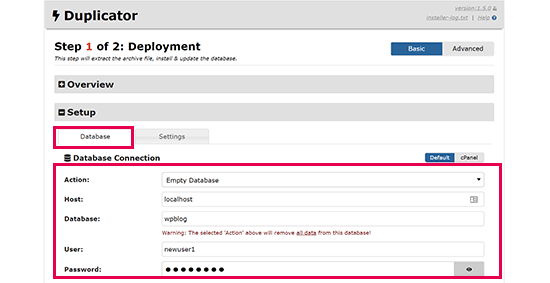
W sekcji Konfiguracja zostaniesz poproszony o wpisz swojego hosta MySQL, nazwę bazy danych, nazwę użytkownika i hasło.
Twój host będzie prawdopodobnie hostem lokalnym. Następnie wpiszesz szczegóły bazy danych, którą utworzyłeś we wcześniejszym kroku.
Następnie kliknij przycisk “Zatwierdź”, aby upewnić się, że wpiszesz prawidłowe dane.
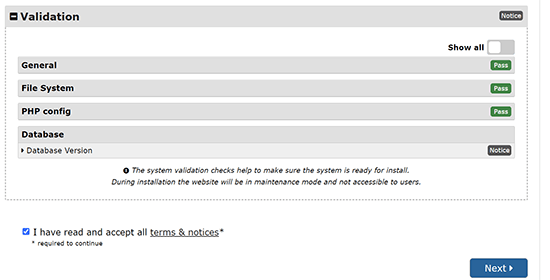
Następnie kliknij przycisk “Dalej”, aby kontynuować.
Duplicator będzie teraz importować twoją kopię zapasową bazy danych WordPress z archiwum do nowej bazy danych.
Zaktualizuje również adresy URL wskazujące na witrynę regionalną i twoją nową witrynę na żywo.
Możesz teraz kliknąć przycisk “Admin Login”, aby wpisz obszar administracyjny WordPress twojej witryny na żywo.

Po zalogowaniu się na twoją witrynę, Duplicator automatycznie wyczyści pliki instalacyjne.
To wszystko. Pomyślnie przeniosłeś WordPressa z lokalnego serwera na twoją witrynę live.
Metoda 2: Ręczne przeniesienie WordPressa z regionalnego serwera na witrynę Live
W tej metodzie pokażemy, jak ręcznie przenieść WordPressa z lokalnego serwera na twoją witrynę na żywo. Będzie to przydatne, jeśli pierwsza metoda nie zadziała lub jeśli wolisz zrobić to ręcznie.
Krok 1: Eksport lokalnej bazy danych WordPress
Pierwszą rzeczą, którą musisz zrobić, to wyeksportować twoją lokalną bazę danych WordPress. W tym celu użyjemy phpMyAdmin.
Jeśli nie jesteś z nim zaznajomiony, to warto zapoznać się z naszym przewodnikiem po zarządzaniu bazą danych WordPress za pomocą phpMyAdmin.
Wystarczy wejść na stronę http://localhost/phpmyadmin/ i kliknąć na twoją bazę danych WordPress. Następnie kliknij przycisk “Eksportuj” na górnym pasku menu.

W opcji “Metoda eksportu:” można wybrać “Szybka” lub “Niestandardowa”. Dostosuj zapewni więcej opcji eksportu twojej bazy danych.
Zalecamy jednak wybranie opcji “Szybko”, a następnie kliknięcie przycisku “Dalej”, aby pobrać twoją bazę danych.

Krok 2: Wgranie plików WordPress na witrynę Live
Teraz będziemy musieli przenieść wszystkie pliki twojej witryny internetowej do witryny na żywo.
Aby rozpocząć, otwórz klienta FTP i połącz się z twoim kontem hostingowym.
Po połączeniu się z twoją witryną na żywo, upewnij się, że przesyłasz pliki do właściwego katalogu. Na przykład, jeśli witryna ma być hostowana pod adresem “yoursite.com”, wszystkie pliki należy przesłać do katalogu public_html.
Teraz wybierz twoje lokalne pliki WordPress i prześlij je na swój serwer live.
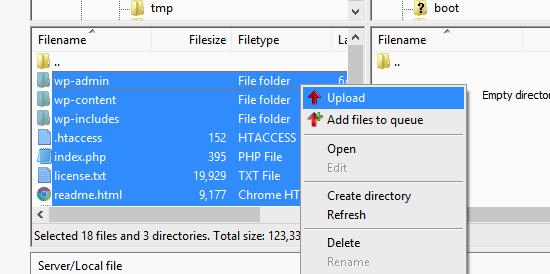
Krok 3: Utwórz bazę danych MySQL na twojej witrynie Live
Podczas gdy twój klient FTP przesyła pliki WordPress, możesz rozpocząć importowanie bazy danych na serwer live.
Większość dostawców hostingu WordPress oferuje cPanel do zarządzania twoim kontem hostingowym, więc pokażemy ci, jak utworzyć bazę danych za pomocą cPanel.
Najpierw należy zalogować się do twojego kokpitu cPanel i kliknąć ikonkę “Kreator baz danych MySQL”, która znajduje się w sekcji “Bazy danych”.

Na następnym ekranie można utworzyć nową bazę danych.
Musisz podać nazwę twojej bazy danych, a następnie kliknąć “Utwórz bazę danych”.

cPanel automatycznie utworzy teraz nową bazę danych.
Następnie wpisz nazwę użytkownika i hasło dla twojego nowego użytkownika, a następnie kliknij “Utwórz użytkownika”.
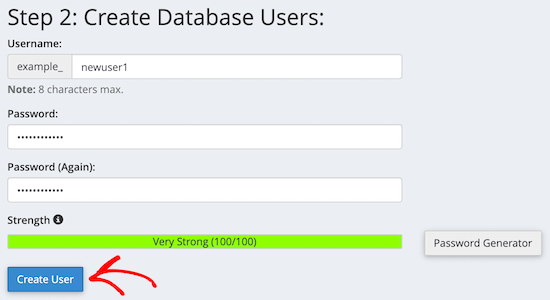
Następnie należy dodać utworzonego użytkownika do bazy danych.
Najpierw zaznacz pole wyboru “Wszystkie uprawnienia”.
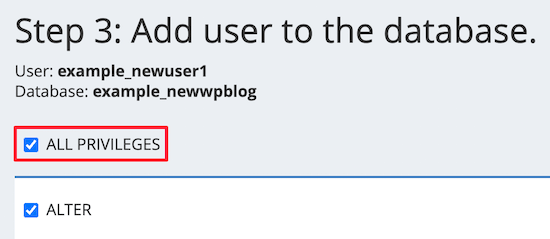
Następnie przewiń w dół i kliknij “Wprowadź zmiany”, aby zapisać twoje zmiany.
Pomyślnie utworzyłeś nową bazę danych dla twojej witryny WordPress na żywo.
Krok 4: Importowanie bazy danych WordPress do witryny Live
Następnym krokiem w procesie jest importowanie twojej bazy danych WordPress.
Przejdź do twojego kokpitu cPanel, przewiń w dół do sekcji “Bazy danych” i kliknij “phpMyAdmin”.
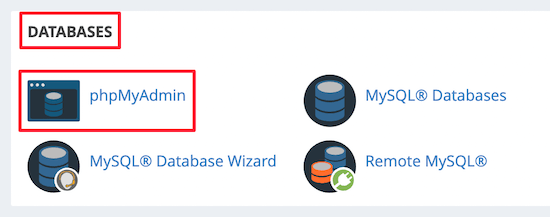
Spowoduje to przejście do phpMyAdmin, gdzie należy kliknąć utworzoną powyżej bazę danych. phpMyAdmin wyświetli twoją nową bazę danych bez tabel.
Następnie kliknij kartę “Importuj” w górnym menu. Na stronie importowania kliknij przycisk “Wybierz plik”, a następnie wybierz plik bazy danych z witryny regionalnej, który zapisałeś w pierwszym kroku.
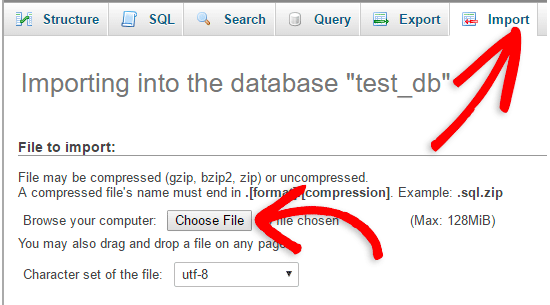
Następnie kliknij przycisk “Go” na dole strony. Twoja baza danych zostanie automatycznie importowana do phpMyadmin.
Krok 5: Zmiana adresu URL witryny
Teraz musisz zmienić adres URL witryny w bazie danych, aby połączyć się z twoją witryną WordPress na żywo.
W phpMyAdmin, poszukaj tabeli wp_options w twojej bazie danych, którą właśnie importowałeś powyżej.
Jeśli zmieniłeś prefiks bazy danych, to zamiast wp_options może być {new_prefix}_options.
Następnie kliknij przycisk “Przeglądaj” obok wp_options. Możesz też kliknąć odnośnik na panelu bocznym, aby otworzyć stronę z listą pól w tabeli wp_options.
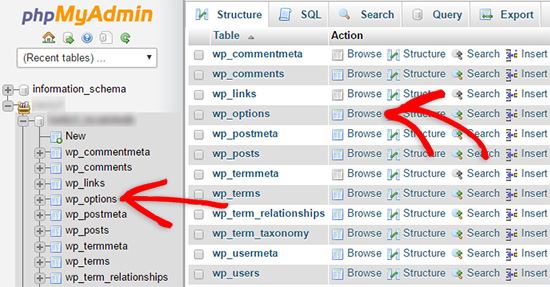
Następnie w kolumnie options_name należy wyszukać opcję siteurl.
Następnie kliknij ikonkę “Edytuj”.

Spowoduje to wyświetlenie okna, w którym można edytować pole.
W polu wejściowym option_value zobaczysz adres URL twojej regionalnej instalacji, który będzie czymś w rodzaju http://localhost/test.
W tym polu należy wstawić adres URL twojej nowej witryny, na przykład: https: //www.wpbeginner.com.
Następnie możesz zapisać pole, klikając przycisk “Dalej”.
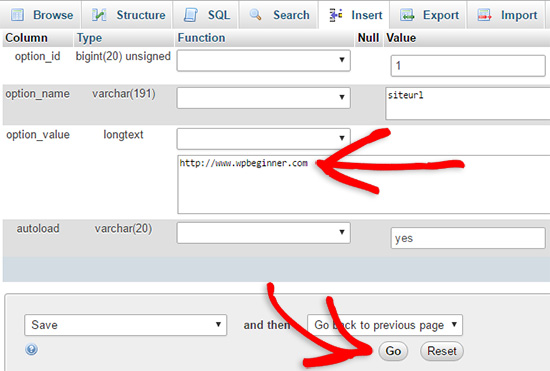
Następnie należy wykonać te same kroki, co powyżej dla nazwy opcji strony głównej. Menu wp_options może mieć kilka stron. Zazwyczaj opcja strony głównej znajduje się na drugiej stronie.
Następnie zaktualizuj adres URL strony głównej, aby był taki sam jak adres URL twojej witryny na żywo.
Krok 6: Skonfiguruj swoją witrynę Live
Teraz, gdy importowałeś bazę danych i przesłałeś swoją treść, nadszedł czas, aby skonfigurować WordPress.
W tym momencie twoja witryna powinna wyświetlać błąd“Błąd nawiązywania połączenia z bazą danych“.
Aby to poprawić, połącz się z twoją witryną internetową za pomocą klienta FTP i otwórz plik wp-config.php.
Poszukiwane będą następujące linie kodu:
1 2 3 4 5 6 7 8 9 | // ** MySQL settings - You can get this info from your web host ** ///** The name of the database for WordPress */define( 'DB_NAME', 'database_name_here' );/** MySQL database username */define( 'DB_USER', 'username_here' );/** MySQL database password */define( 'DB_PASSWORD', 'password_here' );/** MySQL hostname */define( 'DB_HOST', 'localhost' ); |
Będziesz musiał podać nazwę bazy danych, nazwę użytkownika i hasło, które utworzyłeś wcześniej.
Następnie zapisz plik wp-config. php i prześlij go z powrotem na twój serwer hostingowy WordPress.
Teraz, gdy użytkownik przejdzie na twoją witrynę internetową, powinna ona działać na żywo.
Następnie musisz logować się do twojego panelu administracyjnego WordPress i przejść do Ustawienia ” Ogólne. Następnie, nie zmieniając niczego, przewiń do dołu i kliknij przycisk “Zapisz zmiany”.
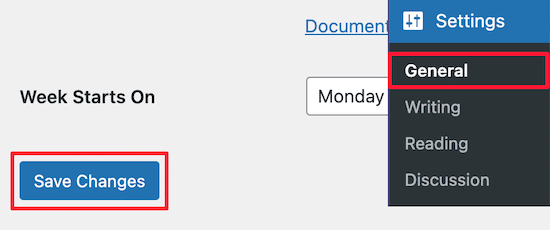
Dzięki temu adres URL twojej witryny zostanie poprawiony wszędzie tam, gdzie powinien.
Gdy to zrobisz, przejdź do Ustawienia ” Bezpośrednie odnośniki, a następnie przewiń w dół i kliknij “Zapisz zmiany”, aby upewnić się, że wszystkie odnośniki do wpisów działają poprawnie.

Krok 7: Poprawka obrazków i naprawiono odnośniki poprzez aktualizację ścieżek.
Za każdym razem, gdy przenosisz witrynę WordPress z jednej domeny do drugiej lub z serwera regionalnego do witryny na żywo, napotkasz niedziałające odnośniki i brakujące obrazki.
Pokażemy dwa sposoby aktualizacji adresów URL. Możesz wybrać ten, który najbardziej Ci odpowiada.
1. Aktualizacja adresów URL za pomocą wtyczki Search & Replace Everything (zalecane)
Najbezpieczniejszym sposobem na poprawienie tego jest użycie Search & Replace Everything. Jest to potężna wtyczka WordPress, która pozwala łatwo wykonywać zadania masowej aktualizacji na twojej witrynie internetowej bez pisania skomplikowanych zapytań do bazy danych.
Najpierw należy zainstalować i włączyć wtyczkę Search & Replace Everything.
Po włączaniu przejdź do strony Narzędzia ” WP Wyszukaj i zamień.
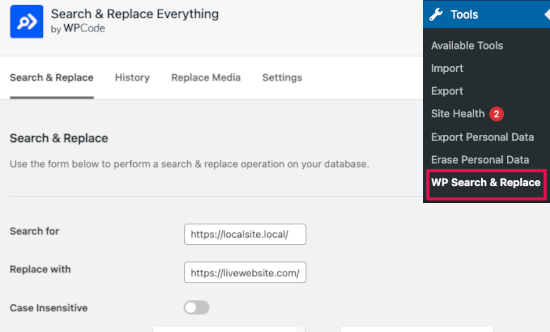
Następnie wpisz adres URL witryny regionalnej w polu “Wyszukaj” i adres URL witryny rzeczywistej w polu “Zamień na”.
Przewiń nieco i kliknij “Wybierz wszystko” pod tabelami. Dzięki temu wtyczka będzie szukać starego adresu URL wszędzie w bazie danych.

Teraz kliknij przycisk “Podgląd wyszukiwania i zamiany”, aby kontynuować.
Wtyczka przeszuka twoją bazę danych pod kątem wszystkich instancji starego adresu URL, a następnie wyświetli podgląd wyników.
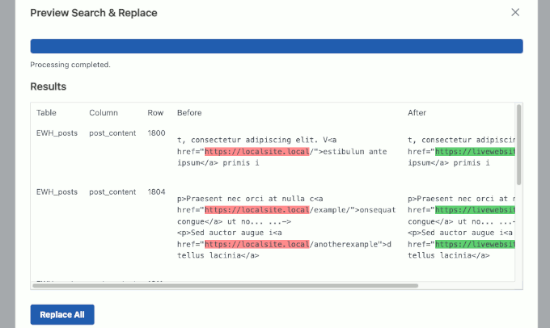
Jeśli wszystko wygląda dobrze, kliknij “Zastąp wszystko”, aby zapisać zmiany.
Zobaczysz ostrzeżenie o wprowadzanych zmianach. Kliknij “Tak”, aby kontynuować.
Wtyczka zaktualizuje teraz bazę danych i zastąpi lokalne adresy URL twoim obecnym, aktualnym adresem URL witryny internetowej.
2. Ręczna aktualizacja adresów URL (zaawansowane)
Innym sposobem aktualizacji adresów URL jest użycie następującego zapytania SQL:
1 | UPDATE wp_posts SET post_content = REPLACE(post_content, 'localhost/test/', 'www.yourlivesite.com/'); |
Wystarczy przejść do phpMyAdmin, kliknąć na twoją bazę danych, a następnie kliknąć na “SQL” z górnego menu i dodać powyższe zapytanie.
Upewnij się, że zmieniłeś je na adresy URL twojej witryny regionalnej i witryny na żywo, a następnie kliknij przycisk “Przejdź”.
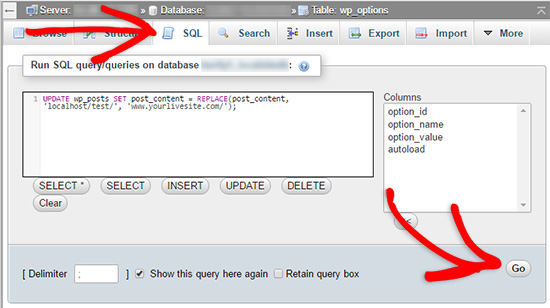
To wszystko. Pomyślnie przeprowadziłeś migrację WordPressa z twojego regionalnego serwera na witrynę live.
Miejmy nadzieję, że twoja witryna internetowa na żywo działa sprawnie. W przypadku powiadomienia o jakichkolwiek błędach, możesz zapoznać się z naszym przewodnikiem po typowych błędach WordPress, aby uzyskać pomoc w rozwiązywaniu problemów.
Mamy nadzieję, że ten artykuł pomógł ci przenieść WordPressa z serwera lokalnego na witrynę live. Możesz również zapoznać się z naszym przewodnikiem na temat przenoszenia witryny na żywo na serwer lokalny lub zapoznać się z ostateczną listą kontrolną migracji witryny, aby poznać praktyczne kroki migracji WordPress.
If you liked this article, then please subscribe to our YouTube Channel for WordPress video tutorials. You can also find us on Twitter and Facebook.





Axel
I love this entry, I use it as a checklist every time I make a migration.
WPBeginner Support
Hey Axel,
Glad you find it useful Don’t forget to join us on Twitter for more WordPress tips and tutorials.
Don’t forget to join us on Twitter for more WordPress tips and tutorials.
Admin
Gary
I keep getting stopped at step 4. when I import my datatbase I get the following error
#1231 – Variable ‘character_set_client’ can’t be set to the value of ‘NULL’
I only have limited sql knowledge and never done anything like this before. any help/guidance would be greatly appreciated
Andrew
Hello,
So I got to step 6 without any issues until my website failing to become live. I went into my wordpress general setting and my site url was still a localhost. Am I suppose to change the site url before I upload it into the ftp program and into my host, or can i leave that as localhost? Or, do i change the site url in wordpress after i’ve uploaded my files into my hosting site?
This page was super helpful, thanks!
Daneesh
Hi. Thanks so much for this, excellent tutorial. I seem to have got stopped at Step 6. I am still getting a “Error establishing database connection” error. DO i need to change the hostname field in the config.php too? and what do i change that to?
Simon
Amazing, it worked, thank you.
sornanun
Thank you very much.
Annete Momanyi
Thank you for the article. I have managed to sort my problem after following these steps.
Arash
Hello there,
I have two questions and I’d be grateful if you could help me!
1) Why do I have two ht-docs and wp-content folders inside my WordPress folder?
2) When I move my WordPress website from a localhost to the live host, It’s possible to remove my localhost or should I keep it forever?
Thanks in advance!
Matze
1) By installing WordPress on your hosted server, these docs/folders will be automatically added. I think while uploading your files from local to live via FTP __ht-docs__ and __wp-content__ just weren’t replaced.
But please check your local files which are normally located in the WAMP/MAMP folders unter __htdocs__ . Are there also two copies of the datas? Then you should find out, which one is the right one …
2) At the time uploading your files from local to live, the local datas are a backup. After some weeks, changing and editing your live site on the server you can delete the locals.
But you should create a backup regular and store the datas local (Quote: “If you are doing this on a regular basis, then we highly recommend that you get BackupBuddy because it will make your life easy. You will thank us for that later”)!
Hope it helps
Starfleet Nnaemeka
Wow! What a wonderful tutorial , seriously i really appreciate the effort you guys brought out to write these tutorial. Thanks it really helped me to set up my website build on wordpress from localhost on wampserver.
Leo Laroche
i have followed all the steps, but when i type in my website the old website comes up. Can someone help me please.
rachel asakome
i have followed steps 1-5, but i am not sure where my site is. sorry it sounds really dumb but i am not great with technology. I have uploaded the files, but when i type in my website the old website comes up
Justas
server DNS address could not be found.
ERR_NAME_NOT_RESOLVED
I changed everything accordingly, but still can’t connect.
Carrie
Could you please explain on how to do this with webmatrix? I have a PC and my wordpress install on my local PC was with webmatrix. I do not have a MAC. Where on webmatrix do I export? I am confused about this. Also, you have create a db in cpanel my sql. Where do I save this new db? On the cpanel someplace or on my local pc hard drive and under what name? I have a domain with go daddy and a web hosting I purchased. They said to do a brand new fresh install of wordpress from there site…. why would I do this? I already have my wordpress via webmatrix on my local pc this is where the website I built resides. How do I get this on my web hosting? Confused on the db stuff and how to get my local wp files/db to my web host. Thank you.
Neo An
Very clear!
Thank you very much!
Milica
This is a great tutorial. Thanks a lot!
Amber
I have followed all of these steps and when I view my site it is showing my content like words and links but none of the decorative stuff or plugins etc. My menus are showing up as just a list of words as if I created a page without any real CSS. My CSS files are not missing so I do not know where the mess up is happening. I tried to do the part about fixing broken links and I am not 100% of what I should put after the localhost part. I used the name of the folder that my entire wordpress database/files/etc are in. I cannot seam to figure out what is going wrong.
Abdul
@AMBER and all those struggling with the same issue, the problem with the deployment process of WordPress’ database is due to the empirical replacement of your local URI with the live site’s URI as explained in this article at Step 7. If you just execute the UPDATE SQL statement as shown, you, most of the time, end up corrupting your database. Why? The reason is simple: WordPress has a way of serializing some metadata for its own convenience. This post explains it pretty well: nacin.com/2010/04/18/wordpress-serializing-data
If you look at this array:
array( ‘apple’, ‘banana’, ‘orange’ ),
when serialized it looks like this:
a:3:{i:0;s:5:”apple”;i:1;s:6:”banana”;i:2;s:6:”orange”;},
where:
– a:3 stands for “array of size 3”
– i:0; i:1; i:2 stand for “integer index 0; integer index 1; integer index 2″ respectively
– s:5:”apple” stands for “string, length 5, data=apple”
– s:6:”banana” stands for “string, length 6, data=banana”, etc.
As you can see, any serialized string is stored along with information about it’s length. So when you do a simple search and replace in your tables, all occurrences will be replaced indeed but the string’s length metadata won’t.
In the case your local URL’s length equals your live site’s URL length, then you’re lucky; if they don’t match then you’re in trouble.
The question now is: “How do I fix this?”. I’m happy to say that, fortunately, there are many plugins that can help you with this but one that’s really simple and good at it is “Better Search Replace”.
Simply install this plugin in your local WordPress installation and proceed as explained in this article. The only place where you can safely replace your local URL is in the wp_options table as explained at Step 5.
Once you’re done installing the plugin, in the admin panel, go to “Tools, Better Search Replace”, in the “Search” text box type your local site’s URL (e.g. http://localhost:12345) and in the “Replace with” text box, type your live site’s URL (e.g. http://www.example.com) and you should be ready to go. Just make sure you don’t include any trailing forward slash “/” in the URL (at the end like http://localhost:12345/ or http://www.example.com/)
I hope this explanation was useful and please let me know if it helped.
Happy coding!
Simon
Hi,
Brilliant article and very easy to follow.
However, as a WordPress virgin I am struggling with the whole concept of having a separate database from the website. I have created everything locally on my PC. But the local PHP Admin will allow me to use however many characters i like in naming my database but my remote server/host (123-reg) will only allow 9 (my original had 11) so…. the database name locally is different from the database name remotely. I have exported the database tables and imported them in to the remote database, renamed my wp-config to point to the new shorter database name with the correct user name and password but i am still getting the ‘Error establishing a database connection’
message. Any suggestions?
Could the fact that the tables are exported from a database with a different name from the one they are being imported to make a difference?
Gabriel
Hello I made all of your steps but I can see only a white page. It doesn’t notify me an error.
I upload everything in a subdirectory of my website. It’s because of that? Is there a solution?
Patrick Hasch
Great article, if the upload of zipped files doesn’t work try uploading .sql files instead.
Tony
I also faced the same problem.
John James
Hello. From your step 6, you said we should change database name, user and password. Are we supposed to change the hostname too?
WPBeginner Support
See step 3 to find out your hostname and use that instead.
Admin
John
Step 3 says nothing about host names.
WPBeginner Support
When you are creating a database on your webhost, you will be able to see the hostname. If you don’t then this means you are using localhost.
Mohd Hasan
i followed all steps but going to install.php page , someone can help me , i really need your help
Gabor
Hello!
i have 500 internal error on server.
I think the problem is with .htaccess.
Can u help in this?
Dawn
I am having this same issue. I followed every step exactly, I fixed the wp-config.php file and re-uploaded it, but now when I go to my live site it says,
“This page isn’t working
[my site] is currently unable to handle this request.
HTTP ERROR 500”
Dawn
I should have said that that is the error I get when I try to go to my wp-admin. When I go to the site itself it’s blank.
Axel
The solution for image references is to execute the following scripts on your DB:
(I can’t write the real scripts because wpbeginner.com thinks I’m doing SQL injection :\ )
UPDATE wp_posts to set the value of column guid to the value of function REPLACE(guid, ‘http://old.site.url’, ‘http://new.site.url’)
AND
UPDATE wp_postmeta to SET the value of column meta_value to the value of function REPLACE(meta_value, ‘http://old.site.url’, ‘http://new.site.url’)
Also don’t forget to check permissions for wp-content/uploads to ensure you can add more images.
Aimy
Hi,
Thanks for this. I did everything as you described. It seemed that everything went well apart the front page that shows nothing but just the navigation menu.
When I go to the page builder of the front page it shows that there is nothing added there.
Any advice?
Krishna
Dear wpbeginner owner
Its working for me !
thank you very much!
Philippe
Damn I’m so lucky wpbeginner exists, I’ve finally managed to get my website to work thanks to this post, I had to fight my way trough (there is an older database-version on my webhosts server) but I did it thanks to you guys!
Umai Hassan
URL Changing
I have changed the URL in wp_option table but only home page loads correctly other pages links are still set to localhost/something ??
What should I do to change all links??
Cos
Brilliant article – thanks! Got through the process without a hitch first-off :-)))
Dan Odaka
Hey, after doing all that, when I go to my site I get a page that shows me the index of wordpress and not my site. what do I do?
WPBeginner Support
This could happen due to an incomplete file transfer. Try to upload your WordPress files again.
Admin
Sonja
Hi. thank you very much for this post. It seems to be very helpful and I’ve tried to follow every step, but now that I’m done, when I go to my URL I get a “Server not found” error (The host shows me a preview with “under-construction” and their logo, which was online before I uploaded the data and database – shouldn’t I at least get that?). Do you have any ideas where I might have gone wrong, and is it best to delete everything and start again from scratch, or overwrite it, or look for any particular errors?
Thank you for any help!
WPBeginner Support
You may have installed WordPress outside your public directory.
Admin
Hugues Pinsonneault
im wondering if you have any recommendation for developing locally new functionalities on a local dev install, while the client can still do updates on the real database.
shah
Hi
Thankyou for the details, but i am still not able to get the path of images correct inspite of the changes done … i have my folders in public_html and have my db created …my live website is working fine except for the pic / logos
zarna
My wordpress site went live but my images are not getting replicated and they aren’t visible. Can you please guide me what should be the images folder structure while uploading it to live ??
Your help and guidance would be appreciable.. Thank you.
Coil McCoy
Great post !!!
Only the last part doesn’t worked for me, the pictures and links still missing !
Any clue?
thank you
Vinish Chaudhary
Hello,
All great beside this You don’t have permission to access / on this server.Don’t know why it is showing when I try to access my site.I have done all steps like you said but getting this error can anyone please help me to solve this problem.
Sudais
Instead of this long way,I use a plugin called wp all in one migration,I just need to import a single file using a plugin when I go live and all done,no playing with databases,etc.I think everyone should do that saves alot of time and handywork.
hiren
can u put the demo ..
thanks.
hiren patel.
Paul
Great article ! But I’m still stuck at the last step. Images aren’t showing on my website.
Well in fact they does, but only on my PC. Everybody else is getting a buggy website.
Farooq Bashir
Wow .. Great Article sir
Its Perfect Working.
Thanks
Bikram Ray
Hi,
No doubt; a very useful article. But I got stuck in the last step. I ran the SQL update query but still having issues regarding image path.
Just one thing; while uploading the file through FTP, I did not upload the wordpress folder (the test folder) rather I uploaded whatever inside it.. So in the server there is only the folders and files directly placed under ‘public_html ‘
Regards,
Bikram
Kay
DIDN’T WORK!!
Error
SQL query:
—
— Database: `wordpress`
—
CREATE DATABASE IF NOT EXISTS `wordpress` DEFAULT CHARACTER SET utf8 COLLATE utf8_general_ci;
MySQL said: Documentation
#1044 – Access denied for user ‘ksalim’@’localhost’ to database ‘wordpress’
WPBeginner Support
Please check your database name, mysql username and password.
Admin
Damilola
A very awesome article, it really made a project i was working on for a client already on my local machine easy to move to his server, i mean i literally tried to develop the website all over again and it was such a pain in the ass….Thank you
WPBeginner Support
Glad you found it helpful. Don’t forget to join us on Facebook for more WordPress tips and tutorials.
Admin
Tim Vincent
Thank you so much for this guide. I struggled doing this for some time before finding this. I followed it word for word and all seems to work. I am very grateful!
WPBeginner Support
We are glad you found it helpful. Don’ forget to follow us on Twitter for more WordPress tips and tutorials.
Admin
sonu
hello! syed
i want to ask you to from where i get the best free wordpress simple attractive theme which laterly i planned to upload on the live server….any help would be much appreciated….thanks…
WPBeginner Support
See our list of 37 simple WordPress themes you should try.
Admin
sonu
hello! syed
i want to ask you when we upload the worpress site from locahost to live server….i just want to ask the wordpress having lot of files and inside the wp-content/themes/… having three different types of theme like twenty fourteen,twenty thirteen ,so is it needed to upload all these themes or not….help would be much appreciated…..thnks…..
Ridhik
No,u just upload the theme folder that currently activated in your site.
Andres Paz Soldan
Thank you! This was very useful!
WPBeginner Support
Hi Andres, glad you found it useful.
Admin
Lellys
First of, thank you!
I did everything and my site is working, but when I need to login on my wp-admin, it show me a blank screen and nothing happens. Any idea?
paddy lutaaya
thank you for this article i have followed the steps and uploaded my website to c panel but it has failed to work it brings internal error please help me solve this thank you
WPBeginner Support
Please see our guide on how to fix internal server error in WordPress.
Admin
Phillip Pilkington
Allgreat advise except step 6. I have not got past this stage, the advice is not clear. My website shows the Error Establishing Database Connection. This next part doesn’t explain anything to me.
“To fix this, connect to your website using an FTP client and edit wp-config.php file. Provide the database name, user and password you created earlier in Step 3. Save the wp-config.php file and upload it back to your server. Visit your website, and it should be live now. ”
I am connect via ftp, then just edit the file….no, nothing happens from here.I open the file in aneditor but I don’t make any changes because it does not show anything about whatis expalined.
Regards,
Tyler Hall
Hey, I am currently transferring the files as we speak. Not sure if you found a solution yet (hopefully you have its been 15 days) but you should probably change the hostname: /** MySQL hostname */
define(‘DB_HOST’, ‘ ‘ your hostname before should have been your localhost or similar.
Himanshu
Thanks for the post. Really helped solve my problem. Although I faced some issues with database importing. After much effort, updating the phpmyadmin version fixed it for me. If possible you could also include common errors in each section, so that a beginner doesn’t get lost. As it happens, most likely you are going to face some error here and there. Other than that great post. Thanks.
WPBeginner Support
@Himanshu Thanks for the Feedback, we really appreciate it.
Admin
Ola
Hi,
Thanks for this, the steps are so direct and you made WordPress uploading fun.
Andy
Hi. When I go to my website it says Welcome to: yourwebsite.com
This Web page is parked for FREE, courtesy of GoDaddy.com. Do I have to register my domain? I just thought of a random website name to put in for the changing site url step 5. Also when I enter the local host site I get the message the webpage could not be found. What should I do?